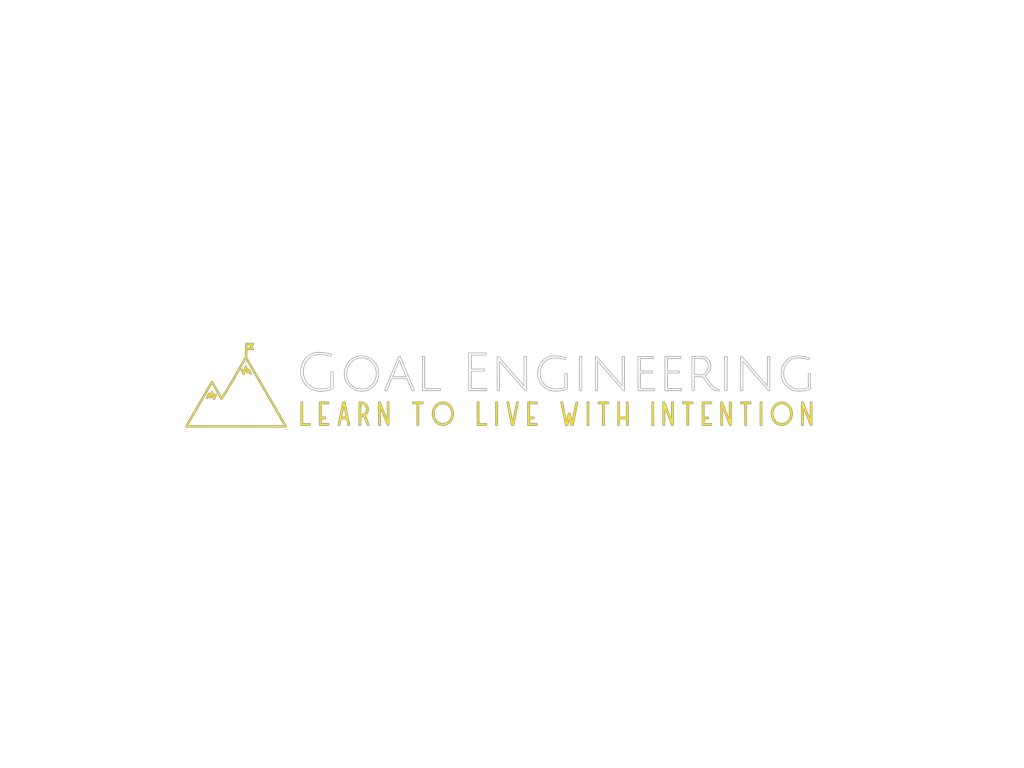Your big ambitions will never happen if you never learn how to begin. Goals are the only mechanism by which you can change your life and reach your dreams. To make them happen, you need to learn how to set them up right, and in this article, I’ll show you my simple process to help you start setting goals.
To start setting goals, use these four steps:
- Set 4 goals in each area of life, including faith, family, finances, and fitness.
- Plan each goal 4 levels deep, including identity, vision, milestones, and action steps.
- Start.
- Track your goals in 4 periods, including daily, weekly, quarterly, and yearly.
This is what I call The 4-4-4 Goal-setting System because of the 4 goals, 4 levels, and 4 time periods of tracking. It keeps things simple by focusing only on the essential steps of goal-setting.
I’ve been working on this system for over 15 years. I’ve engineered it based on what I learned from summarizing over 400 non-fiction books, serving a 24-month mission for my church, and practicing it to achieve big goals like running a marathon, starting a family, and becoming a business owner.
To use this guide I recommend you take just one goal through each step before using it for all of your goals. By doing this you will master the process and then will be able to use the system on any goal you set. The details of each step are important and if you spread yourself too thin by setting too many goals at once, you’ll not be able to take advantage of this robust system.
Now let’s get to it with step 1!
1. Set 4 Goals
“Less, but better, because it concentrates on the essential aspects, and [you] are not burdened with non-essentials. Back to purity, back to simplicity.” ― Dieter Rams
One of the biggest problems I see people make when setting goals is that they set too many. This leads to overwhelm and makes it easy to quit before you see results.
If you want your goals to flourish, you must set less, more focused goals.
There are four areas of life to set goals in for balance and happiness:
- Faith (or spirituality)
- Family (or social)
- Finances
- Fitness
Everything you do, even what you’re doing right now, falls into one of these categories. They are the foundational pillars upon which a successful life is built. That’s why I refer to them as the 4 pillars of life.
When one suffers, the others have to carry extra weight and begin suffering also. But when they all flourish, they build each other up, putting you in an upward spiral of success.
Your fitness impacts how much money you earn, as do your relationships. Your faith can improve your relationships, finances, and fitness.
These 4 pillars are all interconnected and rise or fall together.
To determine your 4 goals look at these sources:
- Who inspires you? What about their life do you want to emulate?
- Think of the happiest times in your life. What were you doing?
- What activities, people, beliefs, and exercises light you up inside?
My favorite way to do this is what’s known as Warren Buffett’s 2-list method.
Buffett taught his personal pilot that to set effective goals, he should create two lists. The first was made by writing out all he wanted to accomplish. And the second came by circling the top 5 most important goals from that list.
Use the questions above to write out 6-10 goal ideas in each of the four pillars of life I mentioned above. Then circle your top one in each pillar.
Narrowing them down might be hard, but it’s vital that you go for what will have the biggest impact in your life. You can do a “tournament” in which you make two of your goal ideas go head to head and you pick just one to move on to the next round.
Another gold standard to help you narrow your goals down is Gary Keller’s The ONE Thing question:
“What’s the One Thing I can do, such that by doing it, everything else will be easier or unnecessary?”
Take just enough time on this to feel good about your goals but not so much that you overthink it and get stuck. Once you begin you’ll get valuable data that will show you how to modify your goals. But we’ll get to that in a minute, first, you need to learn how to refine your goals to make them deep.
2. Plan 4 Levels Deep
“Never mind searching for who you are. Search for the person you aspire to be.” — Robert Brault
In a recent study, scientists found that smokers who began to see themselves as having a new identity as non-smokers are significantly more likely to quit than if they just say “I’m trying to quit.”
When you take on a new identity, you improve your chances of changing yourself.
The problem is that we too often set shallow goals that don’t take advantage of this truth. It’s not because we don’t want an identity shift, that’s usually hidden behind every goal. It’s just that we don’t know how to bring it out.
Identity is the deepest level of every goal. It has the biggest impact on our motivation to change, but we usually set goals like “I want to run 3x per week” instead of “I want to become a runner.”
To discover the identity you seek that’s behind each lower level of your goals, do the Seven Levels of Why exercise.
Start with your initial goal, then ask yourself “why do I want to do this?” Once you have your answer, repeat the question. Do this seven times total and you’ll start to uncover the deep and powerful desires behind your goals.
It might go something like this:
- I want to run 3x per week.
- …because I want to be healthy.
- I want to be healthy because it feels good and makes me productive.
- Why feel good and be productive? So I can be a better Dad.
- I want to be a better Dad because it feels good to be good to others, especially my family.
- Why do I want to be good to others? Because deep down all I really want is to connect with people, especially those I love most.
- Why is connection important to me? Because it makes me feel better than anything else.
See how deep that gets?! Even this simple example is starting to bring up feelings inside of me that are making me want to go on a run. And the best part is that you can do this with every one of your goals.
If I stopped here I’d have way more motivation every time I go running, but there are other levels of your goals to establish for success.
These are the four levels you need to have for each of your goals:
- Identity, which we’ve already talked about.
- Vision, which means visualizing your ideal situation.
- Weekly milestones and outcomes that lead to the identity and vision you seek.
- Daily action steps that will get you to your weekly milestones.
These create a natural flow that leads to you achieving your biggest dreams and becoming your best self:
Daily actions → Weekly outcomes → Vision is now reality → Identity shift
Let’s take our example of running 3x per week as an example. If this were my initial goal, here are the 4 levels I might set up for it:
- Action: Run 3x per week
- Weekly Outcome: Lose 0.5% body fat and improve mile pace by 15 sec.
- Vision: I have 12% body fat and can run a mile in 7 minutes.
- Identity: I am a fit person so I can better connect with my family by doing fun activities with them because I love them and connecting with them makes me feel better than anything else.
Do this with all four of your goals and you’ll have a solid foundation upon which you can begin getting the life you want.
If you’re just starting though, go through the entire process with just one goal at first so you can master the methods and make them habits!
3. Start
“You don’t have to be great to start, but you have to start to be great.” — Zig Ziglar
The only way to make your goals become reality is action. Every other step is worth nothing without this one.
A few years ago I wanted to get into writing so I emailed a popular writer I’d been following. His response surprised me, but not for the reason you might think.
What really caught me off guard was how simple and profound his answer was:
“Just begin.”
That was all the advice I needed, and six months later I’d written over 100 articles on Medium.com. He later surprised me by asking me to write for him and I’ve been doing so ever since.
I’ve written over 700 blog posts since, and it was all because he helped me get an action mindset.
You should begin before you think you’re ready for at least two reasons:
- You’ll improve faster by starting than by thinking.
- You can only get data about how your goals are after you start.
Let’s talk about the second one first. It’s impossible to tell how your goals are going to go when you’re in the “Set” or “Plan” stages. When you begin, however, you start to see how easy or hard your goal is, and how much you like it.
With this information, you can adjust your goal to make it more achievable. If you struggle to reach your action steps consistently, lower them and increase your timeline. And if you find your action steps are too easy, increase them. You can always adjust once you’re moving forward.
It’s easy to change the direction of a moving ship, but impossible to change course if you’re sitting still.
Now let’s talk about why just beginning before you think you’re ready makes you improve faster. It has to do with this quote from Joe Polish:
“It’s better to be prolific than perfect.”
There was once a ceramics teacher that divided her class into two groups for an experiment. Both groups had the same goal of creating the best pot they could.
The first group was to spend their time planning, designing, and crafting the best pot they possibly could. Their task was to make only one perfect pot.
The second group was instructed to make as many pots as possible. They were to learn and improve from each one they created, but to focus on continuing to make new pots.
At the end of the semester, it was time to determine which group had created the better pots. Which group do you think won?
The group that had worked to create as many pots as possible won because they worked through their imperfections rather than trying to think through them.
Just start, make a lot of “pots” (which translates to repetitions of your action steps), and you’ll get where you want to be.
4. Track Your Goals in 4 Time Periods
“If you can’t measure it, you can’t improve it.” — Peter Drucker
Research from the American Psychological Association shows that the more frequently you track your goals, the more likely you are to achieve them.
That same research also confirms that not all forms of tracking are created equal. Tracking how much weight you lost, rather than just tracking how much you exercised, for instance, is more likely to make you actually lose weight.
In other words, you need to track your action steps and the outcomes you seek. Because you can’t see the results of these end goals on a daily basis, you must track them on longer time periods.
You can track most goals, like weight loss, on a weekly basis. Either you lost weight or you didn’t. But some goals, like your identity shift, require a longer time period even.
That’s why you need to check in with yourself each quarter and year as well. Those weekly milestones will add up to the longer-term desired changes you’re striving for. And you can only see those on a yearly or quarterly basis.
It’s best to track your goals on an 84-day or 12-week cycle with a week break in between. There are four of these each year, or four quarters as people commonly call them.
If you only set yearly goals, you get burnt out thinking of too distant of a result you want. With a 12-week cycle you get refreshed four times a year instead of just at the new year.
This gives you four time periods to track your goals, which also align with your four levels:
- Daily (action steps)
- Weekly (outcomes)
- Quarterly (vision)
- Yearly (identity)
You can see an identity shift over a year but not quarterly, daily, or weekly. The same is true for your vision, it’s a lot easier to see on a quarterly basis than daily or weekly ones.
To track your goals, find the method that works best for you. Here are a few ideas to get you started:
- Spreadsheets. This is what I use and I love that it gives me total control of how I break down my goals and track them. I can change it to be whatever I want. The disadvantage of this method is that you have to build it yourself. You can have mine if you want though, just enter your name and email right here.
- Journals. These are great if you like writing by hand, which is actually shown to help you remember things better. It’s also nice that these are usually done for you, but you have to conform to the author’s way of setting goals.
- Apps. There are a ton of habit-forming and goal-setting apps out there, just search the app store. The main benefit to these is that they can help you stay accountable with reminders, unlike spreadsheets or journals. What I don’t love about apps, though, is that they lack customizability. Even worse, they usually focus only on the low-level action steps and not the identity, vision, and outcomes.
Whatever you choose, just make sure it’s something you enjoy using or you won’t stick with it. That’s vital because sticking to your tracking is the surest way to stick to your goals!
In Summary
Here’s a quick summary of my 4-4-4 Goal-Setting System which is the best way to start setting goals:
- Set 4 goals in the areas of faith, family, finances, and fitness.
- Plan 4 levels deep, including identity, vision, outcomes, and action steps.
- Just begin to get data you can use to improve your goals and to start improving faster.
- Track your goals in 4 time periods, including daily, weekly, quarterly, and yearly.





